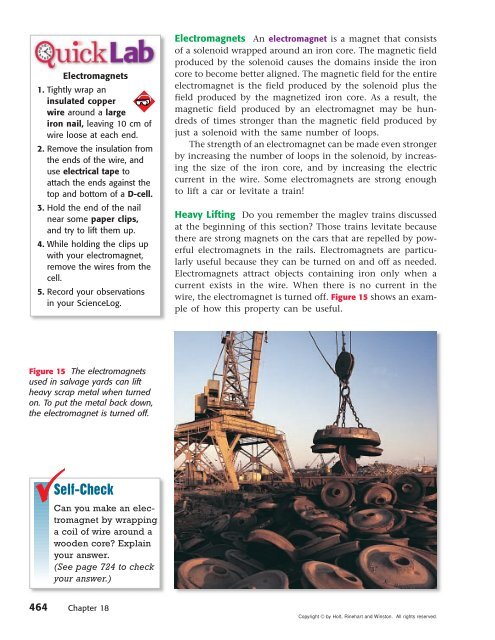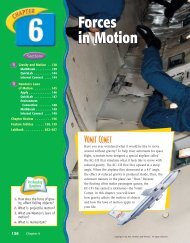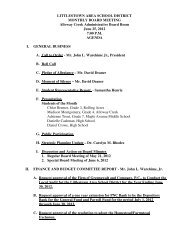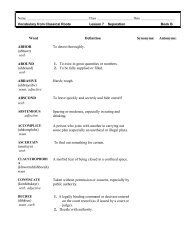Electromagnetism Electromagnetism
Electromagnetism Electromagnetism
Electromagnetism Electromagnetism
Create successful ePaper yourself
Turn your PDF publications into a flip-book with our unique Google optimized e-Paper software.
Figure 15 The electromagnets<br />
used in salvage yards can lift<br />
heavy scrap metal when turned<br />
on. To put the metal back down,<br />
the electromagnet is turned off.<br />
464<br />
Electromagnets<br />
1. Tightly wrap an<br />
insulated copper<br />
wire around a large<br />
iron nail, leaving 10 cm of<br />
wire loose at each end.<br />
2. Remove the insulation from<br />
the ends of the wire, and<br />
use electrical tape to<br />
attach the ends against the<br />
top and bottom of a D-cell.<br />
3. Hold the end of the nail<br />
near some paper clips,<br />
and try to lift them up.<br />
4. While holding the clips up<br />
with your electromagnet,<br />
remove the wires from the<br />
cell.<br />
5. Record your observations<br />
in your ScienceLog.<br />
Self-Check<br />
Can you make an electromagnet<br />
by wrapping<br />
a coil of wire around a<br />
wooden core? Explain<br />
your answer.<br />
(See page 724 to check<br />
your answer.)<br />
Chapter 18<br />
Electromagnets An electromagnet is a magnet that consists<br />
of a solenoid wrapped around an iron core. The magnetic field<br />
produced by the solenoid causes the domains inside the iron<br />
core to become better aligned. The magnetic field for the entire<br />
electromagnet is the field produced by the solenoid plus the<br />
field produced by the magnetized iron core. As a result, the<br />
magnetic field produced by an electromagnet may be hundreds<br />
of times stronger than the magnetic field produced by<br />
just a solenoid with the same number of loops.<br />
The strength of an electromagnet can be made even stronger<br />
by increasing the number of loops in the solenoid, by increasing<br />
the size of the iron core, and by increasing the electric<br />
current in the wire. Some electromagnets are strong enough<br />
to lift a car or levitate a train!<br />
Heavy Lifting Do you remember the maglev trains discussed<br />
at the beginning of this section? Those trains levitate because<br />
there are strong magnets on the cars that are repelled by powerful<br />
electromagnets in the rails. Electromagnets are particularly<br />
useful because they can be turned on and off as needed.<br />
Electromagnets attract objects containing iron only when a<br />
current exists in the wire. When there is no current in the<br />
wire, the electromagnet is turned off. Figure 15 shows an example<br />
of how this property can be useful.<br />
Copyright © by Holt, Rinehart and Winston. All rights reserved.





